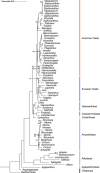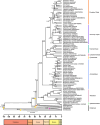The origin and diversification of Amaryllidaceae: A phylogenetic and biogeographic analysis
- PMID: 40936225
- PMCID: PMC12464465
- DOI: 10.1002/ajb2.70092
The origin and diversification of Amaryllidaceae: A phylogenetic and biogeographic analysis
Abstract
Premise: Previous angiosperm-wide studies estimated that the geophytic family Amaryllidaceae diverged in Africa 87.00-46.77 million years ago (mya), spanning the Cretaceous and Palaeogene periods, including multiple important climatic and geological events. Greater precision on when and where this divergence occurred is lacking due to limited sampling of Amaryllidaceae and the paucity of the monocot fossil record. A robust phylogeny is required to estimate the age and origin of suprageneric groups; however, the evolutionary relationships within Amaryllidaceae are unclear.
Methods: We used 78 plastome protein-coding genes to infer the phylogenetic relationships of Amaryllidaceae and estimated the age of the family using four fossils and five secondary calibration points from across the Asparagales. We conducted a new biogeographic analysis to determine the ancestral origins of Amaryllidaceae and suprageneric groups, providing insights into the drivers of diversification.
Results: Our phylogenetic analyses recovered Amaryllidaceae as monophyletic, with Agapanthoideae sister to Amaryllidoideae and Allioideae. We estimate that Amaryllidaceae diverged in southern Africa 48.6 mya (50.3-46.6 mya) during the early Eocene, a period of elevated global temperatures with increasing seasonal aridity. Our biogeographic analyses indicate that taxa migrated from Africa via the Arabian Peninsula to temperate Asia and beyond during the Miocene.
Conclusions: The comprehensive taxon sampling across Amaryllidaceae, the greater number of genes, and the placement of fossils has made it possible to substantially refine estimates of lineage divergence. Establishing a robust age estimate and reconstructing the biogeographic history has led to a better understanding of evolution within the family, of present-day distributions, and of possible drivers of diversification.
Keywords: Amaryllidaceae; biogeography; divergence times; geophyte; molecular phylogeny; monocot evolution; plastid DNA.
© 2025 The Author(s). American Journal of Botany published by Wiley Periodicals LLC on behalf of Botanical Society of America.
Figures

 ; rhizome =
; rhizome =  ).
).



References
-
- Alley, N. F. , Krieg G. W., and Callen R. A.. 1996. Early tertiary eyre formation, lower Nelly Creek, southern Lake Eyre basin, Australia: Palynological dating of macrofloras and silcrete, and palaeoclimatic interpretations. Australian Journal of Earth Sciences 43: 71‐84.
-
- Baum, D. A. and Smith S. D.. 2013. Tree Thinking. An Introduction to Phylogenetic Biology. Roberts and Company Publishers, Greenwood Village, Colorado, USA.
-
- Bitencourt, C. , Nürk N. M., Rapini A., Fishbein M., Simões A. O., Middleton D. J., Meve U., et al. 2021. Evolution of Dispersal, Habit, and Pollination in Africa Pushed Apocynaceae Diversification After the Eocene‐Oligocene Climate Transition. Frontiers in Ecology and Evolution 9: 719741.
-
- Boettner, C. , Klinghammer G., Boers N., Westerhold T., and Marwan N.. 2021. Early‐warning signals for Cenozoic climate transitions. Quaternary Science Reviews 270: 107177.
-
- Bouchenak‐Khelladi, Y. , Muasya A. M., and Linder H. P.. 2014. A revised evolutionary history of Poales: origins and diversification. Botanical Journal of the Linnean Society 175: 4‐16.
MeSH terms
LinkOut - more resources
Full Text Sources

